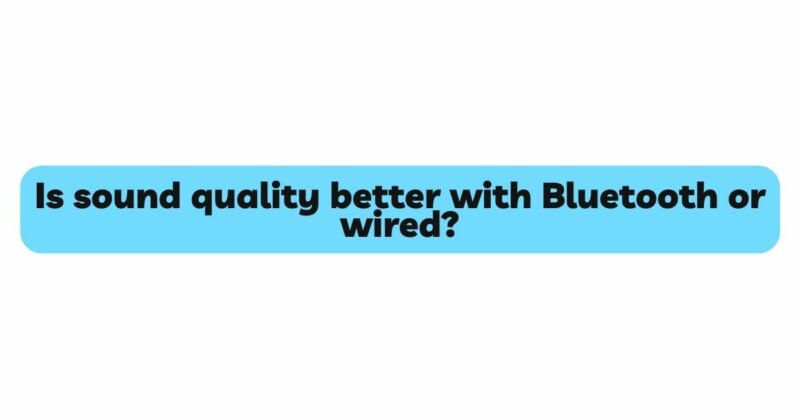The pursuit of optimal sound quality has fueled ongoing debates among audiophiles and music enthusiasts alike. In recent years, the rise of wireless technology, particularly Bluetooth, has posed a challenge to the supremacy of traditional wired connections. This article delves into the intricacies of audio reproduction, dissecting the characteristics and limitations of both Bluetooth and wired connections to explore the ever-evolving question: Is sound quality truly better with Bluetooth or wired connections?
The Battle of the Transmission Methods
At the core of the Bluetooth vs. wired debate lies the battle between wireless and physical connections. Wired connections have been the bedrock of audio fidelity for decades, offering a direct, uncompressed path for audio signals. On the other hand, Bluetooth technology introduces a wireless dimension, enabling devices to communicate and stream audio without the need for cables.
Wired Connections: The Classic Contender
Wired connections, be it analog or digital, have long been synonymous with high-quality sound reproduction. Analog connections, often in the form of 3.5mm audio jacks or RCA cables, deliver audio signals with minimal interference and signal degradation. Digital connections, like USB and optical cables, offer the advantage of transmitting audio in a binary format, ensuring that the audio signal remains unchanged during transmission.
The hallmark of wired connections is their ability to maintain the integrity of the audio signal from source to output. Unlike wireless transmissions, wired connections are inherently immune to interference and signal loss, providing audiophiles with a consistent and unadulterated auditory experience. This makes wired connections particularly appealing in scenarios where sound quality takes precedence over convenience.
Bluetooth: The Wireless Contender
Bluetooth audio technology has revolutionized the way we consume music. The allure of wireless freedom and seamless connectivity has captivated users across the spectrum. However, this convenience comes at a cost. Bluetooth audio transmission involves data compression and wireless interference, factors that can potentially impact audio quality.
Bluetooth audio employs codecs – algorithms that compress and decompress audio data – to transmit music wirelessly. While older codecs like SBC can introduce perceptible audio degradation, newer ones like aptX and LDAC have emerged to address this concern. These codecs aim to deliver near-lossless audio quality, minimizing the perceptual differences between Bluetooth and wired connections.
Understanding Audio Compression
One of the pivotal factors influencing sound quality in the Bluetooth vs. wired debate is audio compression. Wired connections, particularly digital ones, transmit audio in an uncompressed format, ensuring that the original audio data remains unaltered. This results in pristine sound quality, replicating the artist’s intent without compromise.
Bluetooth, due to the constraints of wireless transmission, necessitates audio compression to facilitate efficient data transfer. Compression algorithms remove certain audio data considered less crucial for human perception. While advanced codecs have mitigated the impact of compression, it remains an inherent characteristic of Bluetooth audio transmission.
The Audiophile’s Dilemma
Audiophiles, individuals with a discerning ear for audio quality, are particularly invested in the Bluetooth vs. wired debate. These aficionados prioritize sound purity, seeking to replicate the artist’s original vision with utmost precision. For audiophiles, wired connections have long been the preferred choice, given their ability to deliver unadulterated, high-fidelity audio.
However, the landscape is shifting. Bluetooth technology, driven by improved codecs and wireless advancements, has made notable strides in narrowing the gap between wired and wireless audio quality. For some audiophiles, the convenience of Bluetooth audio and its expanding audio fidelity might just be sufficient to sway their allegiance.
Real-World Listening Scenarios
The effectiveness of both Bluetooth and wired connections can vary based on real-world listening scenarios. In controlled listening environments, where external interference is minimized, the differences between Bluetooth and wired audio might be more pronounced. In contrast, scenarios involving portable Bluetooth speakers, headphones, or car audio systems introduce additional variables, such as ambient noise and room acoustics, which can diminish the perceived disparities between the two connection types.
The Modern Lifestyle and Convenience Factor
In an era defined by mobility and connectivity, the convenience of Bluetooth audio cannot be overstated. The ability to seamlessly switch between devices, move freely without cumbersome cables, and effortlessly stream music has resonated with the modern listener. Bluetooth technology has embedded itself into our daily lives, offering a level of integration that wired connections struggle to match.
On the other hand, wired connections might be perceived as cumbersome in certain scenarios. The need for physical cables and the potential for tangling can limit the ease of use, especially in portable situations. This convenience factor makes Bluetooth an attractive choice, even if it comes with potential audio quality trade-offs.
Conclusion: A Question of Balance
In the dynamic world of audio technology, the Bluetooth vs. wired debate eludes a clear-cut conclusion. Both connection types have their strengths and limitations, catering to different priorities and preferences. Wired connections continue to champion unparalleled audio fidelity, while Bluetooth audio has evolved to offer remarkable convenience and increasingly impressive sound quality.
Ultimately, the choice between Bluetooth and wired connections depends on individual requirements. Audiophiles seeking the utmost in sound purity might lean towards wired connections. Meanwhile, those valuing convenience and the freedom of wireless technology might find Bluetooth audio more aligned with their lifestyle.
As technology progresses, the gap between Bluetooth and wired audio quality continues to narrow. The evolving landscape promises a future where wireless technology and audio fidelity coexist harmoniously, ensuring that users can enjoy their favorite music with the sound quality they desire and the convenience they demand.

